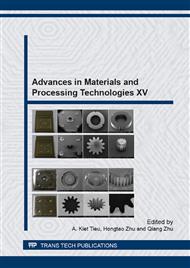p.3
p.9
p.18
p.28
p.39
p.47
p.56
p.63
Numerical Investigation of Knurled Shaft-Hub Connections and Especially of the Joining Process
Abstract:
Faced with increasing cost pressures, manufacturers need to find new solutions for shaft-hub connections. One example is the knurled interference fit, where a shaft with knurls and interference is pressed in a soft hub with a cylindrical bore. At present the potential of the knurled interference fit is not fully used, because there are no general standards available for the design and for the joining process. But the joining process in particular has an important impact on the join strength. A predominantly forming joining process offers some advantages compared to cutting. Forming allows a clearly higher contact pressure over the groove because of the displacement of the hub material, which leads to greater axial reliability. Also, the natural material structure is preserved by the forming, and this, in combination with the hardening of the hub, should allow a higher transmittable torque. The Finite Element Method is used for detailed investigation of the joining process and the transmission behavior in the axial direction. With this method, the local loads, for example the hardening of the hub over the groove due to the formed join, are investigated as well as further parameter variations (e.g., chamfer angle, interference). Hence, an analytical approach for the determination of the necessary joining force was derived.
Info:
Periodical:
Pages:
18-27
Citation:
Online since:
November 2013
Authors:
Price:
Сopyright:
© 2014 Trans Tech Publications Ltd. All Rights Reserved
Share:
Citation:


